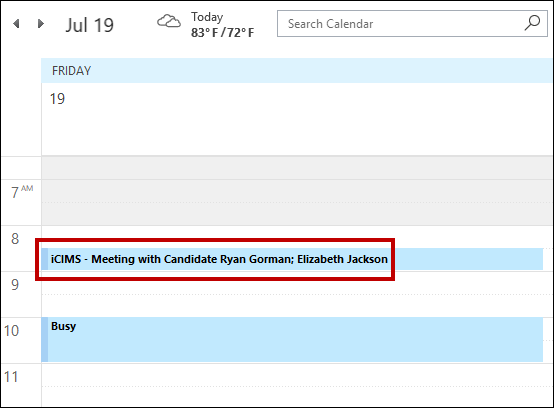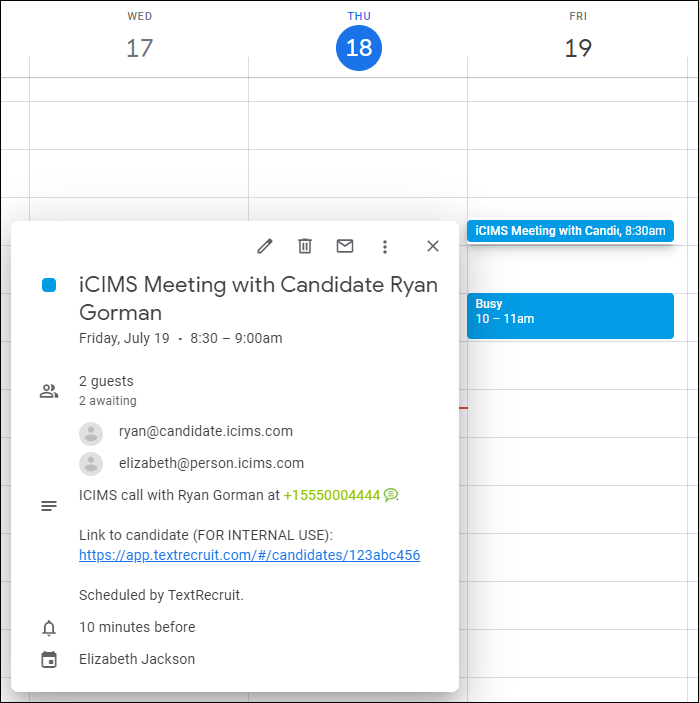Overview
By default, iCIMS Text Engagement users have their Text Engagement in-system calendar synced with their Text Engagement account. Users can optionally sync their iCIMS Text Engagement account with a Google or Microsoft calendar to maintain scheduling with candidates on an external calendar. Users can send candidates calendar links for candidates to self-schedule meetings at the users’ available time slots indicated by their connected calendar.
Note: This article contains information regarding connecting an external Google or Microsoft calendar. For more information on using the default iCIMS Text Engagement calendar for users' self-scheduling of meetings and events, review the
Adding and Managing Meetings and Events via the Text Engagement Calendar article.
This article is composed of the following sections:
Connecting an Automated Scheduling Calendar
The steps below outline how users can sync their Google (e.g., Google Calendar) or Microsoft calendar (e.g., Outlook) with iCIMS Text Engagement via the Automated Scheduling Calendar section of the Preferences menu. For questions regarding supported calendars, please contact iCIMS Technical Support.
- Click the user dropdown in the top right of the Text Engagement web application, then click Preferences and navigate to the Automated Scheduling Calendar section of the Preference Settings page.

- Click the Switch Calendar button; the Switch Calendars popup displays.
- Select the calendar you would like to connect (i.e., Google or Microsoft), then click Next.
- From the next screen, update your time zone, if needed, then click Got It.
- Sign in with the Google or Microsoft account that you want to sync with your Text Engagement account.
- Note: If your browser has a default account cached, you may not be required to enter your email and password; you may be signed in automatically.
- If connecting a Microsoft account, skip to step 7. If connecting a Google account, a message displays that textrecruit.com wants to access your Google account and explains the various permissions associated with syncing your calendar with iCIMS Text Engagement; click Allow to agree to these terms.
- You are redirected back to Text Engagement and a confirmation message displays that the calendar has been connected.
Notes:
- Only one calendar type (i.e., Text Engagement, Google, or Microsoft) can be connected at a time for automated scheduling purposes.
- Users may lose existing calendar data if they disconnect their Google or Microsoft calendar. It is recommended that users only switch their calendar in the Preferences section if they intend to fully switch to a new calendar type.
Automated Scheduling Calendar Options
The Automated Scheduling Calendar Options section of the Preference Settings page contains settings that allow Text Engagement users to configure their availability for automated candidate scheduling via their connected calendar (e.g., Text Engagement, Google, or Microsoft).
- The Scheduled Duration setting allows users to configure a meeting duration available for all meetings scheduled by candidates (i.e., the time slot duration presented to candidates for each meeting time selection); the default is 30 minutes.
- The Minimum Delay Notice setting allows users to configure a scheduling delay to prepare for meetings scheduled by candidates (i.e., how many hours or days of notice the user needs when candidates schedule meetings via their connected calendar link or the digital assistant); the default is 1 hour.
Candidate Self-Scheduling with a Connected Calendar
Text Engagement users can send candidates a unique URL to their synced calendar that allows candidates to schedule an appointment by selecting an available date and time from the user's free times.
This section is broken down into the following categories:
Sending a Calendar Link
Once a user’s calendar is synced with iCIMS Text Engagement, users can send candidates a link to their calendar to automate scheduling. There are two ways to add a calendar link to a message, depending on the area the user is in, described below. Candidates receive a unique URL that allows them to schedule an appointment by selecting an available date and time on the user’s calendar. For more information on the candidate’s role in scheduling, review the
Understanding the Candidate Role in Scheduling section of this article.
- Schedule Message popup: Click the Calendar Link button to add a calendar link from the Schedule Message popup. The link displays as $calendarLink in the Message text box and displays as a URL in the read-only Preview box.
 This image displays adding a calendar link from a scheduled message.
This image displays adding a calendar link from a scheduled message. - Inbox/Candidate Profile: To add a calendar link from the inbox, candidate profile, or the Text Engagement browser extension, click the calendar icon. The link displays in the message text box as $calendarLink; a preview of the URL is not available.
 This image displays adding a calendar link form a candidate profile.
This image displays adding a calendar link form a candidate profile.: The unique calendar link URL is visible to users from the candidate’s conversation history. Users should not click this URL; only candidates should schedule through their URL.
Understanding the Candidate Role in Scheduling
This section describes the candidate experience scheduling a meeting through a calendar link. The steps below are outlined from the candidate's perspective.
Note: Candidates can only schedule dates and times that are considered free on a user’s calendar. For users with synced Microsoft calendars (Exchange or Outlook), the calendar sync takes a user’s busy time and business hours into account (i.e., user availability) from the synced calendar. For users connected to the Text Engagement calendar, they can configure their availability for automated scheduling via the Working Hours section of the Preferences menu. For users with any other calendars, Text Engagement defaults to Standard Hours of 8:30 a.m.-5 p.m. with an hour of busy time for lunch from noon to 1 p.m.
- Click the calendar URL in the text message. The scheduling tool launches in the phone’s default browser.
- Select an available day from the list.
- Note: The calendar only displays days within two weeks of the current date.
- Select an available time from the list. Time slots are determined by the applicable Text Engagement user's Scheduled Duration setting; the default duration is 30 minutes.
- Review or enter the First Name, Last Name, Email, and Mobile Phone Number fields. Then, click Schedule to save this time on the organizer’s calendar.
- A confirmation message displays that the meeting has been scheduled, and you receive a confirmation email if you had provided an email address. Click the Change Appointment link to cancel or reschedule the scheduled meeting, if necessary.
- Notes:
- The Text Engagement user’s email is visible to the candidate on the confirmation page, as the Text Engagement user is considered the organizer of the meeting.
- At this point, the candidate’s meeting is scheduled and visible on the Text Engagement user’s synced calendar. For information on users accessing and editing meetings scheduled by candidates, review the Accessing and Editing Scheduled Meetings section of this article.
Accessing and Editing Scheduled Meetings
Users can only access meetings that candidates have scheduled through Text Engagement on the calendar that they have synced in the Automated Scheduling Calendar section of the Preferences menu. Candidate-scheduled meetings are only accessible via the Text Engagement system when the Text Engagement calendar is connected.
 This image displays an example meeting event scheduled on a Microsoft Outlook calendar.
This image displays an example meeting event scheduled on a Microsoft Outlook calendar. This image displays an example meeting's event details on a Google Calendar.
This image displays an example meeting's event details on a Google Calendar.:
- Users who schedule through the Text Engagement calendar receive an email notification when a candidate initially schedules their meeting or reschedules from the calendar link. This email includes a link to add the meeting to their external calendar.
- Users who schedule through a connected calendar do not receive a notification when a candidate initially schedules their meeting or reschedules from the calendar link. Instead, the meeting is automatically added to or edited in their connected calendar.
- Users can edit meetings from their synced Google or Microsoft calendar through the normal means of editing meetings on that calendar type. Candidate-scheduled meetings can only be edited from within the Text Engagement system when the Text Engagement calendar is connected in the Automated Scheduling Calendar section of the Preferences menu.
- Tip: When canceling or rescheduling, only candidates who have provided an email address are included as a recipient for an updated notification. If a candidate has not provided an email address, users should reach out to candidates via text or other means to reschedule.
- When a calendar link is sent to a candidate who already has a scheduled meeting, the URL opens directly to the confirmation page, where the candidate can view the date and time they are scheduled for and change the appointment time, if necessary. A candidate may only have one active scheduled appointment with a user at a time.




